|
|
Austria
Jul 14, 2019 4:50:54 GMT -7
Post by pieter on Jul 14, 2019 4:50:54 GMT -7
|
|
|
|
Austria
Jul 14, 2019 4:51:43 GMT -7
Post by pieter on Jul 14, 2019 4:51:43 GMT -7
|
|
|
|
Austria
Jul 14, 2019 5:03:40 GMT -7
Post by pieter on Jul 14, 2019 5:03:40 GMT -7
Jaga, the 2 top Nazi officials in the Netherlands, Reich Commissioner of the Netherlands Arthur Seyss-Inquart and the the highest SS and Police Leader in the occupied Netherlands, SS-Obergruppenführer Hanns Albin Rauter were Austrian Nazi's.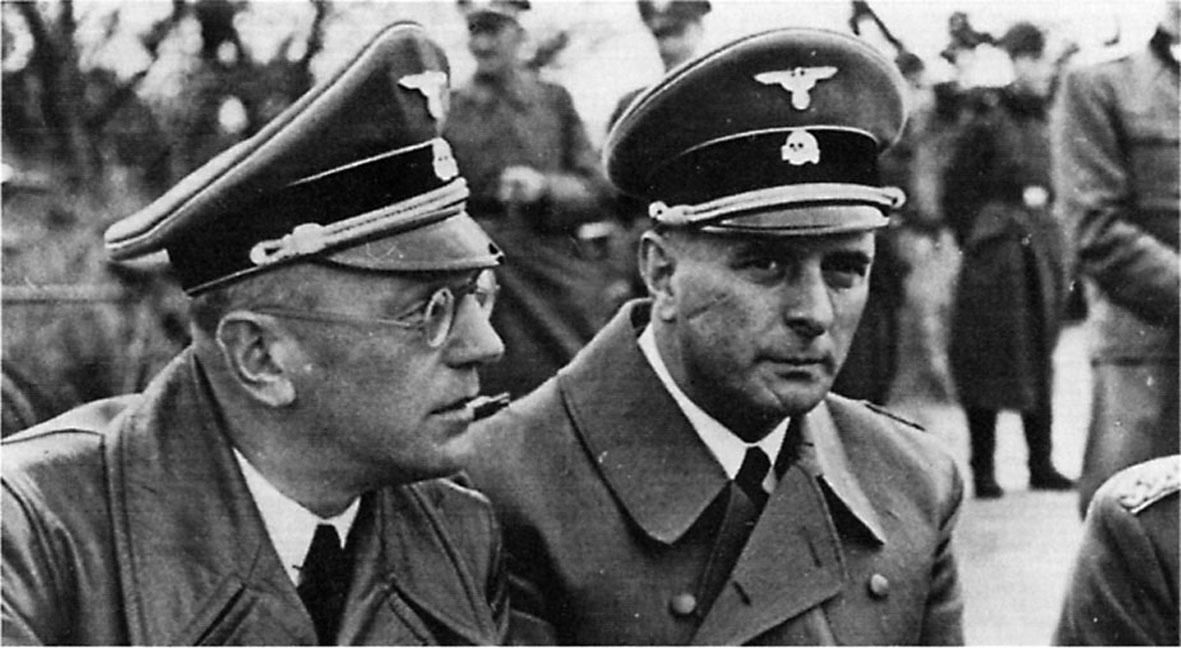 The Austrian Nazi leaders in the Netherlands; Reich Commissioner of the Netherlands Arthur Seyss-Inquart and SS-Obergruppenführer Hanns Albin Rauter The Austrian Nazi leaders in the Netherlands; Reich Commissioner of the Netherlands Arthur Seyss-Inquart and SS-Obergruppenführer Hanns Albin Rauter
|
|
|
|
Austria
Jul 14, 2019 5:11:42 GMT -7
Post by pieter on Jul 14, 2019 5:11:42 GMT -7
|
|
|
|
Austria
Jul 14, 2019 5:18:38 GMT -7
Post by pieter on Jul 14, 2019 5:18:38 GMT -7
|
|
|
|
Austria
Jul 14, 2019 5:22:33 GMT -7
Post by pieter on Jul 14, 2019 5:22:33 GMT -7
|
|
|
|
Austria
Jul 14, 2019 9:21:34 GMT -7
Post by pieter on Jul 14, 2019 9:21:34 GMT -7
Austrian Partition (Poland) Polish-Lithuanian Commonwealth in 1772The Austrian Partition (Polish: zabór austriacki) comprise the former territories of the Polish–Lithuanian Commonwealth acquired by the Habsburg Monarchy during the Partitions of Poland in the late 18th century. The three partitions were conducted jointly by the Russian Empire, the Kingdom of Prussia and Habsburg Austria, resulting in the complete elimination of the Polish Crown. Austria acquired Polish lands during the First Partition of 1772, and Third Partition of Poland in 1795.[1] In the end, the Austrian sector encompassed the second-largest share of the Commonwealth's population after Russia;[note 1] over 2.65 million people living on 128,900 km2 (49,800 sq mi) of land constituting formerly south-central part of the Republic.History Polish-Lithuanian Commonwealth in 1772The Austrian Partition (Polish: zabór austriacki) comprise the former territories of the Polish–Lithuanian Commonwealth acquired by the Habsburg Monarchy during the Partitions of Poland in the late 18th century. The three partitions were conducted jointly by the Russian Empire, the Kingdom of Prussia and Habsburg Austria, resulting in the complete elimination of the Polish Crown. Austria acquired Polish lands during the First Partition of 1772, and Third Partition of Poland in 1795.[1] In the end, the Austrian sector encompassed the second-largest share of the Commonwealth's population after Russia;[note 1] over 2.65 million people living on 128,900 km2 (49,800 sq mi) of land constituting formerly south-central part of the Republic.History The three partitions of the Polish–Lithuanian Commonwealth. The Russian Partition (Red), the Austrian Partition (green), and the Prussian Partition (blue)The territories acquired by Austrian Empire (later the Austro-Hungarian Empire) during the First Partition included the Polish Duchy of Zator and Duchy of Oświęcim, as well as part of Little Poland with the counties of Kraków, Sandomierz and Galicia, less the city of Kraków. In the Third Partition, the annexed lands included Western Galicia and Southern Masovia. Major historical events of the Austrian Partition included: the formation of the Napoleonic Duchy of Warsaw in 1807, which was followed by the 1809 Polish–Austrian War aided by the French, and the victorious Battle of Raszyn resulting in Austrian temporary defeat (1809) marked by the recapture of Kraków and Lwów by the Duchy. However, the fall of Napoleon, leading to abolition of the Duchy at the Congress of Vienna (1815) allowed Austria to regain control. The Congress created the Free City of Kraków protectorate of Austria, Prussia and Russia, which lasted for a decade. It was abolished by Austria, after the crushing of Kraków Uprising in 1846. The formation of the Polish Legions by Piłsudski initially to fight alongside the Austro-Hungarian Army, helped Poland regain its sovereignty in aftermath of World War I.Society The three partitions of the Polish–Lithuanian Commonwealth. The Russian Partition (Red), the Austrian Partition (green), and the Prussian Partition (blue)The territories acquired by Austrian Empire (later the Austro-Hungarian Empire) during the First Partition included the Polish Duchy of Zator and Duchy of Oświęcim, as well as part of Little Poland with the counties of Kraków, Sandomierz and Galicia, less the city of Kraków. In the Third Partition, the annexed lands included Western Galicia and Southern Masovia. Major historical events of the Austrian Partition included: the formation of the Napoleonic Duchy of Warsaw in 1807, which was followed by the 1809 Polish–Austrian War aided by the French, and the victorious Battle of Raszyn resulting in Austrian temporary defeat (1809) marked by the recapture of Kraków and Lwów by the Duchy. However, the fall of Napoleon, leading to abolition of the Duchy at the Congress of Vienna (1815) allowed Austria to regain control. The Congress created the Free City of Kraków protectorate of Austria, Prussia and Russia, which lasted for a decade. It was abolished by Austria, after the crushing of Kraków Uprising in 1846. The formation of the Polish Legions by Piłsudski initially to fight alongside the Austro-Hungarian Army, helped Poland regain its sovereignty in aftermath of World War I.Society Edward Dembowski during the Kraków Uprising against the Austrian rule, 1846For most of the 19th century, the Austrian government made little or no concessions to their Polish constituents, their attitude being that a "patriot was a traitor – unless he was a patriot for the [Austrian] Emperor."[6] However, by the early 20th century – just before the outbreak of World War I and the collapse of Austria-Hungary – out of the three partitions, the Austrian one had the most local autonomy. The local government called Governorate Commission (Polish: Komisja Gubernialna) had considerable influence locally, Polish language was accepted as the official regional language on Polish soil, and used in schools; Polish organizations had some freedom to operate, and Polish parties could formally participate in Austro-Hungarian politics of the empire.Austria-Hungary also de facto encouraged (the flourishing) Ukrainian organizations as a divide and rule tactic. This led to accusations by Poles that "Austria-Hungary had invented Ukrainians". Ukrainians maintained schools (from elementary to higher levels) and newspapers in the Ukrainian language. After 1848 Ukrainians also moved into Austrian politics with their own political parties. Austria-Hungary gave Ukrainians more rights than Ukrainians living in the Russian Empire. Decades after it had ceased to exist its former Ukrainian citizens had positive emotions about Austria-Hungary.EconomyOn the other hand, economically, Galicia was rather backward, and universally regarded as the poorest of the three partitions. There was much corruption during the elections, and the region was seen by the Viennese government as the low priority for investment and development. It was a vast, but constantly struggling region with inefficient agriculture and little industry. In 1900, 60% of the village population (age 12 and over) couldn't read or write. Education was obligatory until the age of 12, but this requirement was often ignored. Between the years 1850 and 1914 it is estimated that about 1 million people from Galicia (mostly Poles) emigrated to United States.[7] Poverty in Austrian Galicia to this day has survived in Polish language as an expression of hopelessness (adage: bieda galicyjska or nędza galicyjska).Administrative divisionThe Austrian Empire divided the former territories of the Commonwealth it obtained into: Edward Dembowski during the Kraków Uprising against the Austrian rule, 1846For most of the 19th century, the Austrian government made little or no concessions to their Polish constituents, their attitude being that a "patriot was a traitor – unless he was a patriot for the [Austrian] Emperor."[6] However, by the early 20th century – just before the outbreak of World War I and the collapse of Austria-Hungary – out of the three partitions, the Austrian one had the most local autonomy. The local government called Governorate Commission (Polish: Komisja Gubernialna) had considerable influence locally, Polish language was accepted as the official regional language on Polish soil, and used in schools; Polish organizations had some freedom to operate, and Polish parties could formally participate in Austro-Hungarian politics of the empire.Austria-Hungary also de facto encouraged (the flourishing) Ukrainian organizations as a divide and rule tactic. This led to accusations by Poles that "Austria-Hungary had invented Ukrainians". Ukrainians maintained schools (from elementary to higher levels) and newspapers in the Ukrainian language. After 1848 Ukrainians also moved into Austrian politics with their own political parties. Austria-Hungary gave Ukrainians more rights than Ukrainians living in the Russian Empire. Decades after it had ceased to exist its former Ukrainian citizens had positive emotions about Austria-Hungary.EconomyOn the other hand, economically, Galicia was rather backward, and universally regarded as the poorest of the three partitions. There was much corruption during the elections, and the region was seen by the Viennese government as the low priority for investment and development. It was a vast, but constantly struggling region with inefficient agriculture and little industry. In 1900, 60% of the village population (age 12 and over) couldn't read or write. Education was obligatory until the age of 12, but this requirement was often ignored. Between the years 1850 and 1914 it is estimated that about 1 million people from Galicia (mostly Poles) emigrated to United States.[7] Poverty in Austrian Galicia to this day has survived in Polish language as an expression of hopelessness (adage: bieda galicyjska or nędza galicyjska).Administrative divisionThe Austrian Empire divided the former territories of the Commonwealth it obtained into:- Kingdom of Galicia and Lodomeria – from 1772 to 1918. - West Galicia – from 1795 to 1809 - Free City of Kraków – from 1815 to 1846 - Two important and major cities of the Austrian partition were Kraków (German: Krakau) and Lwów (German: Lemberg). In the first partition, Austria received the largest share of the formerly Polish population, and the second largest land share (83,000 km² and over 2.65 million people). Austria did not participate in the second partition, and in the third, it received 47,000 km² with 1.2 million people. Overall, Austria gained about 18 percent of the former Commonwealth territory (130,000 km²) and about 32 percent of the population (3.85 million people). From the geographical perspective, much of the Austrian partition corresponded to the Galicia region.Source: WikipediaNotes - The "Austrian sector" is a historical term used by scholars in reference to Commonwealth territories consisting of Polish heritage dating as far back as the first days of Poland's statehood.[2]
- This Ukrainian education system was also in the Polish–Lithuanian Commonwealth.
- The first published in 1948.References 1) - Norman Davies (2005), "Part 4. Galicia: The Austrian Partition", God's Playground A History of Poland: Volume II: 1795 to the Present, Oxford University Press, pp. 102–119, ISBN 0199253404, retrieved November 24, 2012
2) - William Fiddian Reddaway (1971). The Austrian sector, in: Galicia and self-government. The Cambridge History of Poland, Volume 2. CUP Archive. pp. 434–. ISBN 9287148821. Retrieved March 26, 2013.
3) - Norman Davies (2005). Austrian Partition. God's Playground. A History of Poland. The Origins to 1795. Vol. I (revised ed.). Oxford University Press. pp. 367, 393. ISBN 0199253390 – via Google books preview.
4) - Hein Erich Goemans, War and Punishment: The Causes of War Termination and the First World War, Princeton University Press, 2000, ISBN 0-691-04944-0, pp. 104-5
5) - Jerzy Lukowski, Hubert Zawadzki, A Concise History of Poland, Cambridge University Press, 2001, ISBN 0-521-55917-0, p. 129
6) - Anatol Murad (1968). "A patriot was a traitor—unless he was a patriot for the Emperor". Franz Joseph I of Austria and His Empire (first print ed.). Ardent Media. p. 17. Retrieved November 21, 2012.
7) - Andrzej Garlicki, Polsko-Gruziński sojusz wojskowy, Polityka: Wydanie Specjalne 2/2008, ISSN 1730-0525, p. 11-12
8) - Ukrainian Security Policy by Taras Kuzio, 1995, Praeger, ISBN 0275953858 (page 9)
9) - Serhy Yekelchyk Ukraine: Birth of a Modern Nation, Oxford University Press (2007), ISBN 978-0-19-530546-3
10) - Ukraine: A History, 4th Edition by Orest Subtelny, 2009, Toronto, Canada, University of Toronto Press, ISBN 978-1-4426-4016-0 & ISBN 978-1-4426-0991-4
11) - Jeremy Popkin, ed., Media and Revolution: Comparative Perspectives (University of Kentucky Press, 1995)
12) - Mark von Hagen. (2007). War in a European Borderland. University of Washington Press. pg. 4
13) - History of Ukraine – The Land and Its Peoples by Paul Robert Magocsi, University of Toronto Press, 2010, ISBN 1442640855 (page 482)
14) - David Crowley, National Style and Nation-state: Design in Poland from the Vernacular Revival to the International Style, Manchester University Press ND, 1992 ISBN 0-7190-3727-1, p. 12
15) - Piotr Stefan Wandycz, The Price of Freedom: A History of East Central Europe from the Middle Ages to the Present, Routledge (UK), 2001, ISBN 0-415-25491-4, p. 133
|
|
|
|
Austria
Jul 14, 2019 10:48:14 GMT -7
Post by pieter on Jul 14, 2019 10:48:14 GMT -7
Jaga,For me the Austrian partition of Southern Poland plays a role in my life, because the life of my Polish grandmothers family was in Southern-Poland in the Austrian part of Poland. I could speak German with my Polish grandmother, because she spoke German, because she learned German in that Austrian part of Poland. Her knowledge of German, her power (energy) and assertiveness saved her life and that of family members several times during the Warsaw Uprising (1 August – 2 October 1944) where she was a human shield for the German/Austrian Waffen-SS against the Polish Home Army snipers in the district of Mokotow. Her knowledge of German and her extravert and energetic and dominant nature saved her and her husband life in confrontation with looting Ukrainian SS men in Warsaw and helped her in Mauthausen concentration camp in Austria and other places in Austria in her contact with bad Austrian SS-Totenkopfverbände (SS-TV), the men of the SS organization responsible for administering the Nazi concentration camps and extermination camps for Nazi Germany and thus the Mauthausen concentrationcamp in Austria, because Austria was part of Nazi Germany. Ofcourse my grandmother and her group of Polish Roman-Catholic women from Warsaw had to deal with Austrian and German guards of that SS-Totenkopfverbände in Mauthausen, and German and Austrian Kapo's over there. My grandmother was tough, honest and clear about the situation in the camp in her written memoires. The Polish women were seen as inferior Slavic Unternmenschen (subhumans) in comparission with the aryan, Nordic, Germanic Austrian and German Übermenschen in the Austrian/German Nazi view. My grandmother said, that jews had zero chance for survival in the camp. They had the lowest status. After them, also very low in status where the Gypsy prisoners, Roma and Sinti, after them followed the Sovjet Red army soldiers who were starved to death. My Polish grandmother wrote about the motherly, sister, and human feelings of the Polish women who saw Russian boys and men die in front of their eyes, due to lack of food, water and medical care, and physical abuse, terrorisation by SS-Guards and Kapo's. My grandmother saw the terrible scene of a Russian boy who was ripped apart by German shepperd guard dogs of the SS guards. The Polish women had to sleep outside without a roof above their head, and got very little food. Still some of them shared their food in secret via the barbed wire that separated them with the Russians. More than 37,000 non-Jewish Poles were in Mauthausen during the war. Many of them died there or were killed. From March through December 1944, at least 13,826 Jews arrived in Mauthausen, most of them Hungarian and Polish Jews and approximately 500 of them women. The SS had deported virtually all of them from Auschwitz-Birkenau and Plaszow camps to Mauthausen. Thank god for my grandmother outside the camp during her forced labour work for Austrian guards, there were empathic, ethical, social, good Roman-Catholic Austrians. The Polish women got some food from Austrians who saw them as fellow human beings and christians. The women even managed to attend Roman-Catholic masses in a local Roman-Catholic church with a good priest and some good parishioners over there. Even in time of hell, great suffering and hardship there are angels, rescuers and good people. My Polish grandmother thanks her life partly due to the fact that there were good Austrians too. But the situation was very difficult and dangerous for both the Polish women and the good Austrians. Helping concentration camp inmates could result in being sent to a concentration camp, being put in a Gestapo prison and being tortured or execution by firing squad or hanging by the Austrian and German SS, Sicherheitsdienst (SD) or Gestapo.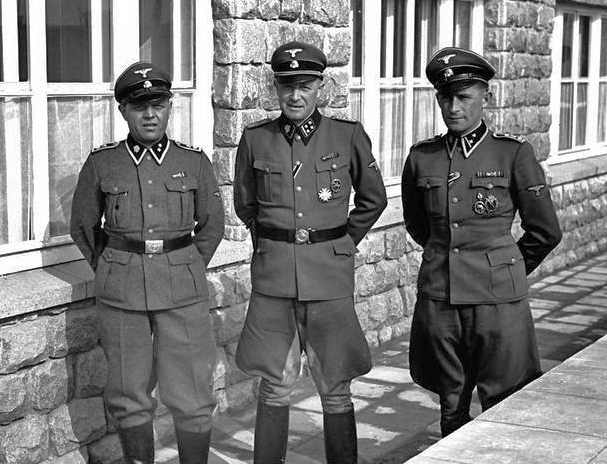 Kommandant Franz Ziereis with SS staff at KL Mauthausen Kommandant Franz Ziereis with SS staff at KL Mauthausen Mauthausen, Austria, An orchestra escorts prisoners destined for execution, 30/07/1942. by Paul Ricken (Yad Vashem DC) Mauthausen, Austria, An orchestra escorts prisoners destined for execution, 30/07/1942. by Paul Ricken (Yad Vashem DC) 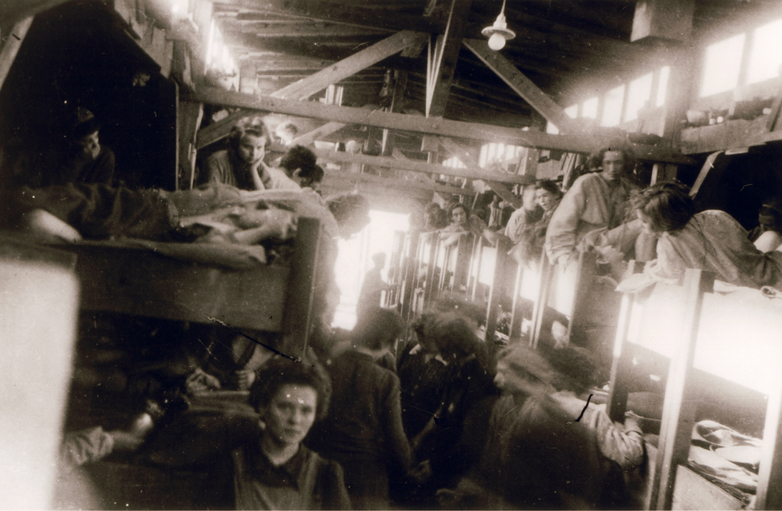 Female prisoners in an infirmary Mauthausen camp barrack after liberation, May 1945 (photo credits: US Holocaust Memorial Museum) Female prisoners in an infirmary Mauthausen camp barrack after liberation, May 1945 (photo credits: US Holocaust Memorial Museum) Himmler visiting Mauthausen concentration camp, you see a prisoner standing in the background Himmler visiting Mauthausen concentration camp, you see a prisoner standing in the background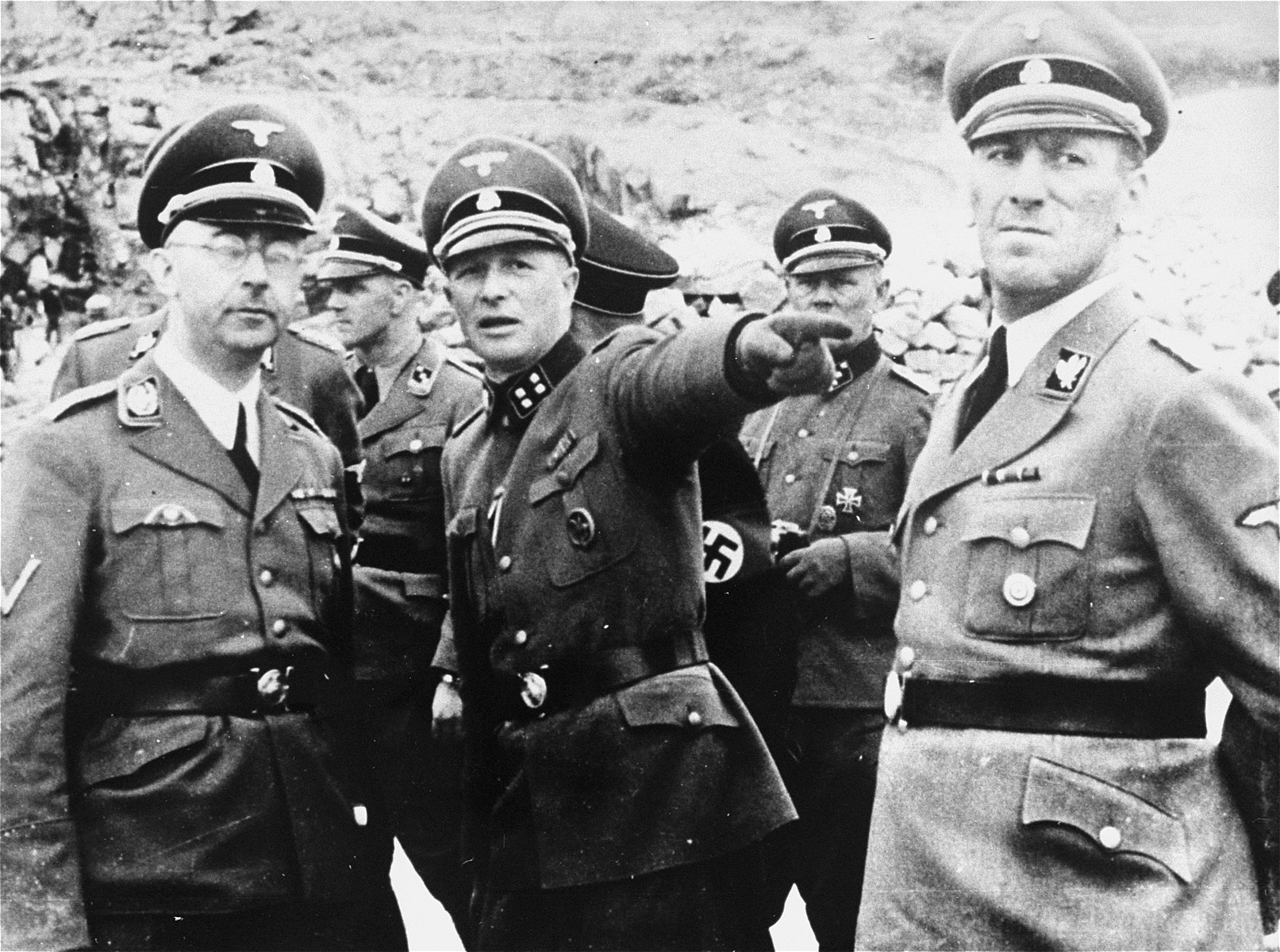 Commandant SS-Obersturmführer Franz Ziereis points out something to Heinrich Himmler and other SS officials while viewing the quarry during an inspection tour of the Mauthausen concentration camp in Austria. Commandant SS-Obersturmführer Franz Ziereis points out something to Heinrich Himmler and other SS officials while viewing the quarry during an inspection tour of the Mauthausen concentration camp in Austria.  Heinrich Himmler inspecting the camp brothel in Mauthausen/Gusen Heinrich Himmler inspecting the camp brothel in Mauthausen/Gusen Heinrich Himmler visits Mauthausen concentration camp. You see camp inmates standing in the distance.Sometimes the SS enticed women into serving in the brothels by promising them more humane treatment or reductions of their indefinite sentence. This caused anger or envy among some female inmates. Nina Michailovna, Russian camp prisoner, reported: "When we found out that a girl in our block was chosen, we caught her and threw a blanket on her and beat her up so badly that she could hardly move. It wasn't clear if she would recover. They just wanted to have a better life and we punished them this way."Both the SD and Gestapo were part of the Reich Main Security Office (Reichssicherheitshauptamt or RSHA), an organization subordinate to Heinrich Himmler in his dual capacities as Chef der Deutschen Polizei (Chief of German Police) and Reichsführer-SS, the head of the Nazi Party's Schutzstaffel (SS). The organization's stated duty was to fight all "enemies of the Reich" inside and outside the borders of Nazi Germany. In the RSHA the Nazi Party's Sicherheitsdienst (SD; SS intelligence service) was combined with the Sicherheitspolizei (SiPo; "Security Police"), which was nominally under the Interior Ministry. The SiPo was composed of two sub-departments, the Geheime Staatspolizei (Gestapo; "Secret State Police") and the Kriminalpolizei (Kripo; "Criminal Police"). Therefor the paramilitary Schutzstaffel (SS) organization had total control over Germany and Austria and the occupied teroritories of the Nazi Third Reich. Via the Schutzstaffel Adolf Hitler and his NSDAP (National Socialist German Workers Party) had total control over Nazi Germany and Nazi Austria. Since the SS men were ideologically brainwashed, indoctrinated with Nazi race ideas and had developed themselves in organisations like the Hitler Jugend and the SA (Sturmabteilung) and the former Reichswehr (First World War), far right Freikorps ("Free Corps") organisations in the years 1918-1920, the twenties and early thirties and some of them in the the Stahlhelm, Bund der Frontsoldaten (English: "Steel Helmet, League of Front Soldiers", also known in short form as Der Stahlhelm). Stahlhelm was one of the many paramilitary organizations that arose after the German defeat of World War I. It was part of the "Black Reichswehr" and in the late days of the Weimar Republic (1918–1933) (operated as the armed branch of the national conservative German National People's Party (DNVP), placed at party gatherings in the position of armed security guards (Saalschutz). After the Nazi seizure of power on 30 January 1933, the new authorities urged to merge the German Stahlhelm into the party's Sturmabteilung (SA) paramilitary organization. Heinrich Himmler visits Mauthausen concentration camp. You see camp inmates standing in the distance.Sometimes the SS enticed women into serving in the brothels by promising them more humane treatment or reductions of their indefinite sentence. This caused anger or envy among some female inmates. Nina Michailovna, Russian camp prisoner, reported: "When we found out that a girl in our block was chosen, we caught her and threw a blanket on her and beat her up so badly that she could hardly move. It wasn't clear if she would recover. They just wanted to have a better life and we punished them this way."Both the SD and Gestapo were part of the Reich Main Security Office (Reichssicherheitshauptamt or RSHA), an organization subordinate to Heinrich Himmler in his dual capacities as Chef der Deutschen Polizei (Chief of German Police) and Reichsführer-SS, the head of the Nazi Party's Schutzstaffel (SS). The organization's stated duty was to fight all "enemies of the Reich" inside and outside the borders of Nazi Germany. In the RSHA the Nazi Party's Sicherheitsdienst (SD; SS intelligence service) was combined with the Sicherheitspolizei (SiPo; "Security Police"), which was nominally under the Interior Ministry. The SiPo was composed of two sub-departments, the Geheime Staatspolizei (Gestapo; "Secret State Police") and the Kriminalpolizei (Kripo; "Criminal Police"). Therefor the paramilitary Schutzstaffel (SS) organization had total control over Germany and Austria and the occupied teroritories of the Nazi Third Reich. Via the Schutzstaffel Adolf Hitler and his NSDAP (National Socialist German Workers Party) had total control over Nazi Germany and Nazi Austria. Since the SS men were ideologically brainwashed, indoctrinated with Nazi race ideas and had developed themselves in organisations like the Hitler Jugend and the SA (Sturmabteilung) and the former Reichswehr (First World War), far right Freikorps ("Free Corps") organisations in the years 1918-1920, the twenties and early thirties and some of them in the the Stahlhelm, Bund der Frontsoldaten (English: "Steel Helmet, League of Front Soldiers", also known in short form as Der Stahlhelm). Stahlhelm was one of the many paramilitary organizations that arose after the German defeat of World War I. It was part of the "Black Reichswehr" and in the late days of the Weimar Republic (1918–1933) (operated as the armed branch of the national conservative German National People's Party (DNVP), placed at party gatherings in the position of armed security guards (Saalschutz). After the Nazi seizure of power on 30 January 1933, the new authorities urged to merge the German Stahlhelm into the party's Sturmabteilung (SA) paramilitary organization.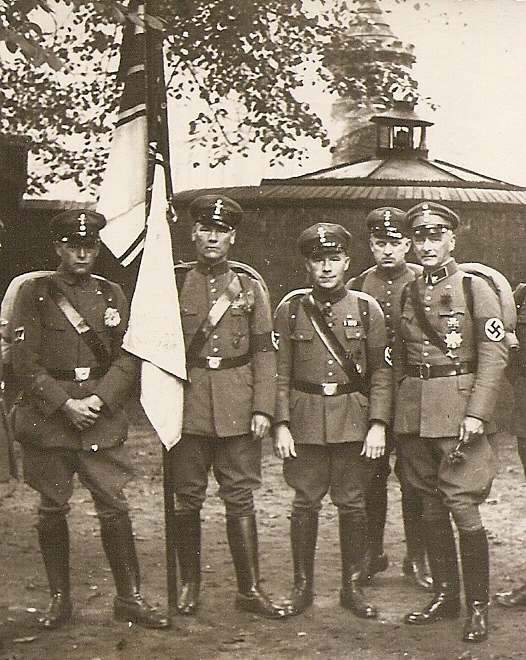 Stahlhelm members in Germany after the incorporation into the SA, 1934Austrian National SocialismAustrian National Socialism was a Pan-German movement that was formed at the beginning of the 20th century. The movement took a concrete form on November 15, 1903 when the German Worker's Party (DAP) was established in Austria with its secretariat stationed in the town of Aussig (now Usti nad Labem in the Czech Republic). It was suppressed under the rule of Engelbert Dollfuss (1932–34), with its political organization, the DNSAP ("German National Socialist Workers' Party") banned in early 1933, but revived and made part of the German Nazi Party (NSDAP) after the German annexation of Austria in 1938. DNSAP Stahlhelm members in Germany after the incorporation into the SA, 1934Austrian National SocialismAustrian National Socialism was a Pan-German movement that was formed at the beginning of the 20th century. The movement took a concrete form on November 15, 1903 when the German Worker's Party (DAP) was established in Austria with its secretariat stationed in the town of Aussig (now Usti nad Labem in the Czech Republic). It was suppressed under the rule of Engelbert Dollfuss (1932–34), with its political organization, the DNSAP ("German National Socialist Workers' Party") banned in early 1933, but revived and made part of the German Nazi Party (NSDAP) after the German annexation of Austria in 1938. DNSAP Deutsche Nationalsozialistische Arbeiterpartei in Austria in 1938 At a party congress in Vienna in May 1918, the DAP changed its name to the Deutsche Nationalsozialistische Arbeiterpartei (DNSAP) and produced a National Socialist Program, which is thought to have influenced the later German Nazi manifesto. Deutsche Nationalsozialistische Arbeiterpartei in Austria in 1938 At a party congress in Vienna in May 1918, the DAP changed its name to the Deutsche Nationalsozialistische Arbeiterpartei (DNSAP) and produced a National Socialist Program, which is thought to have influenced the later German Nazi manifesto.
The Austrian DNSAP split into two factions in 1923, the Deutschsozialen Verein (German-Social Association) led by Dr. Walter Riehl, and the Schulz-Gruppe. After 1930, most former DNSAP members became supporters of the German NSDAP led by Austrian-born Adolf Hitler, and were one of the chief elements leading the pro-Nazi coup in 1938 that brought about the Anschluss of Austria with Germany.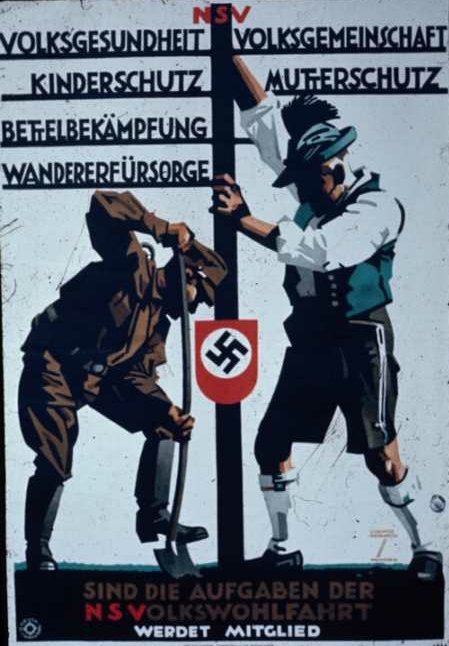  Austrian Nazi party (DNSAP) election poster of 1930Leaders of the party, who were dubbed Landesleiter due to the recognition of Hitler as overall Führer, included Alfred Proksch (1931–33), Hermann Neubacher (1935) and Josef Leopold (1936–38), although real power frequently lay with Theodor Habicht, a German sent by Hitler to oversee Nazi activity in Austria.Cheers, Austrian Nazi party (DNSAP) election poster of 1930Leaders of the party, who were dubbed Landesleiter due to the recognition of Hitler as overall Führer, included Alfred Proksch (1931–33), Hermann Neubacher (1935) and Josef Leopold (1936–38), although real power frequently lay with Theodor Habicht, a German sent by Hitler to oversee Nazi activity in Austria.Cheers,
Pieter
|
|
|
|
Austria
Jul 14, 2019 12:47:10 GMT -7
Post by pieter on Jul 14, 2019 12:47:10 GMT -7
en.wikipedia.org/wiki/Politics_of_Austria 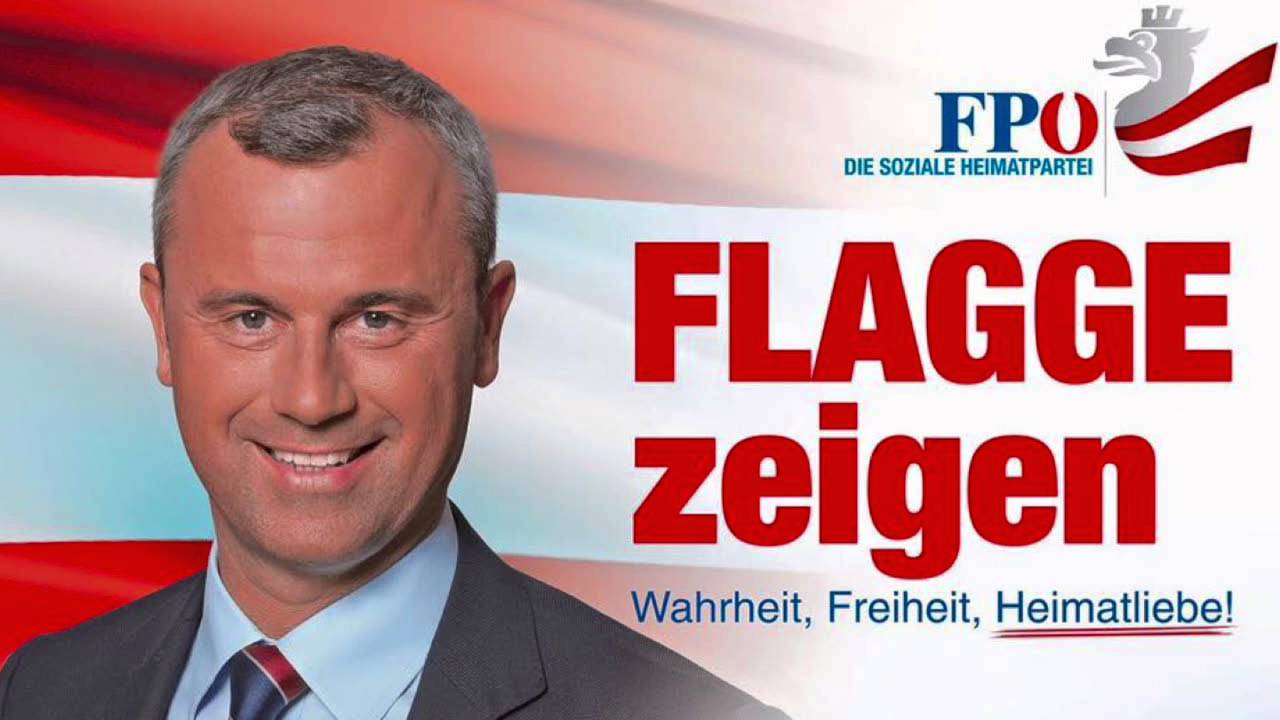 The Freedom Party (Freiheitliche Partei Österreichs, or FPÖ) is a right-wing populist political party that was founded in 1955 as a successor to the Federation of Independents. According to polls, it mainly attracts votes from young people and workers. Their nationalist rhetoric targets Muslims, immigrants and the European Union. The party steadily gained support after Jörg Haider took over leadership of the party in 1986, until it attracted about 27% of the vote in the 1999 elections. After being reduced to 10% in the 2002 elections, they achieved 17.5% in 2008, and 26.0% of the votes in 2017. In 2017 1,316,442 of the 8,857,960 Austrians voted for the FPÖ. The Freedom Party (Freiheitliche Partei Österreichs, or FPÖ) is a right-wing populist political party that was founded in 1955 as a successor to the Federation of Independents. According to polls, it mainly attracts votes from young people and workers. Their nationalist rhetoric targets Muslims, immigrants and the European Union. The party steadily gained support after Jörg Haider took over leadership of the party in 1986, until it attracted about 27% of the vote in the 1999 elections. After being reduced to 10% in the 2002 elections, they achieved 17.5% in 2008, and 26.0% of the votes in 2017. In 2017 1,316,442 of the 8,857,960 Austrians voted for the FPÖ.
|
|
|
|
Austria
Jul 14, 2019 12:50:19 GMT -7
Post by pieter on Jul 14, 2019 12:50:19 GMT -7
Before the present crisis  Sebastian Kurz, chairman of the Austrian People's Party and the youngest Chancellor in Austrian history from December 2017 to May 2019The Austrian People's Party (German: Österreichische Volkspartei; ÖVP) is a conservative Christian-democratic political party in Austria. A successor to the Christian Social Party of the late 19th and early 20th centuries, it was founded immediately following the reestablishment of the Republic of Austria in 1945 and since then has been one of the two largest Austrian political parties with the Social Democratic Party of Austria (SPÖ). In federal governance, the ÖVP has spent most of the postwar era in a grand coalition with the SPÖ. However, the ÖVP won the 2017 election, having the greatest number of seats and formed a coalition with the right-wing populist Freedom Party of Austria (FPÖ). Its chairman Sebastian Kurz was the youngest Chancellor in Austrian history. Sebastian Kurz, chairman of the Austrian People's Party and the youngest Chancellor in Austrian history from December 2017 to May 2019The Austrian People's Party (German: Österreichische Volkspartei; ÖVP) is a conservative Christian-democratic political party in Austria. A successor to the Christian Social Party of the late 19th and early 20th centuries, it was founded immediately following the reestablishment of the Republic of Austria in 1945 and since then has been one of the two largest Austrian political parties with the Social Democratic Party of Austria (SPÖ). In federal governance, the ÖVP has spent most of the postwar era in a grand coalition with the SPÖ. However, the ÖVP won the 2017 election, having the greatest number of seats and formed a coalition with the right-wing populist Freedom Party of Austria (FPÖ). Its chairman Sebastian Kurz was the youngest Chancellor in Austrian history.
|
|
|
|
Austria
Jul 14, 2019 12:53:46 GMT -7
Post by pieter on Jul 14, 2019 12:53:46 GMT -7
  Pamela Rendi-Wagner (born 7 May 1971) is an Austrian physician and politician serving as the chairwoman of the Social Democratic Party (SPÖ) since November 2018. She is the first woman to lead the SPÖ. From March 2017 to December 2017 Rendi-Wagner was Minister of Health and Women. Since November 2017 she is a member of the National Council and since October 2018 she also is the parliamentary leader of her party there.The Social Democratic Party (Sozialdemokratische Partei Österreichs, or SPÖ) is a social democratic/Centre-left political party that was founded in 1888 as the Social Democratic Worker's Party (Sozialdemokratische Arbeiterpartei, or SDAP), when Victor Adler managed to unite the various opposing factions. The party was reconstituted as the Socialist Party of Austria in 1945 (renamed to the Social Democratic Party of Austria in 1991) after being outlawed in 1934. Between 1970 and 1999, it governed the country either alone or with a junior partner, and all but two of the Presidents of Austria since 1945 have either been members of the SPÖ or nominated by it. Originally having a high following among blue-collar workers, it sought to expand its focus on middle class and white-collar workers in the late 1950s. In the 1990s, it started viewing privatization of nationalised industries more openly, after large losses of state owned enterprises came to light. Following the 2008 financial crisis, the party started advocating a global transaction tax. It finished first in the National Council election of 2008 with 29.3% of the vote. The party is a member of the Socialist International and the Party of European Socialists.Red Vienna (German: Rotes Wien) was the nickname of the capital of Austria between 1918 and 1934, when the Social Democrats had the majority and the city was democratically governed for the first time. Pamela Rendi-Wagner (born 7 May 1971) is an Austrian physician and politician serving as the chairwoman of the Social Democratic Party (SPÖ) since November 2018. She is the first woman to lead the SPÖ. From March 2017 to December 2017 Rendi-Wagner was Minister of Health and Women. Since November 2017 she is a member of the National Council and since October 2018 she also is the parliamentary leader of her party there.The Social Democratic Party (Sozialdemokratische Partei Österreichs, or SPÖ) is a social democratic/Centre-left political party that was founded in 1888 as the Social Democratic Worker's Party (Sozialdemokratische Arbeiterpartei, or SDAP), when Victor Adler managed to unite the various opposing factions. The party was reconstituted as the Socialist Party of Austria in 1945 (renamed to the Social Democratic Party of Austria in 1991) after being outlawed in 1934. Between 1970 and 1999, it governed the country either alone or with a junior partner, and all but two of the Presidents of Austria since 1945 have either been members of the SPÖ or nominated by it. Originally having a high following among blue-collar workers, it sought to expand its focus on middle class and white-collar workers in the late 1950s. In the 1990s, it started viewing privatization of nationalised industries more openly, after large losses of state owned enterprises came to light. Following the 2008 financial crisis, the party started advocating a global transaction tax. It finished first in the National Council election of 2008 with 29.3% of the vote. The party is a member of the Socialist International and the Party of European Socialists.Red Vienna (German: Rotes Wien) was the nickname of the capital of Austria between 1918 and 1934, when the Social Democrats had the majority and the city was democratically governed for the first time. ( en.wikipedia.org/wiki/Red_Vienna ) Austromarxism Karl Marx building in Vienna | Photo by Keith Ewing on FlickrAustro-Marxism was a Marxist theoretical current, led by Victor Adler, Otto Bauer, Karl Renner and Max Adler, members of the Social Democratic Workers' Party of Austria in Austria-Hungary and the First Austrian Republic (1918–1934). It is known for its theory of nationality and nationalism, and its attempt to conciliate it with socialism in the imperial context. Hence, Otto Bauer thought of the "personal principle" as a way of gathering the geographically divided members of the same nation. In Social Democracy and the Nationalities Question (1907), he wrote that "The personal principle wants to organize nations not in territorial bodies but in simple association of persons", thus radically disjoining the nation from the territory and making of the nation a non-territorial association. Karl Marx building in Vienna | Photo by Keith Ewing on FlickrAustro-Marxism was a Marxist theoretical current, led by Victor Adler, Otto Bauer, Karl Renner and Max Adler, members of the Social Democratic Workers' Party of Austria in Austria-Hungary and the First Austrian Republic (1918–1934). It is known for its theory of nationality and nationalism, and its attempt to conciliate it with socialism in the imperial context. Hence, Otto Bauer thought of the "personal principle" as a way of gathering the geographically divided members of the same nation. In Social Democracy and the Nationalities Question (1907), he wrote that "The personal principle wants to organize nations not in territorial bodies but in simple association of persons", thus radically disjoining the nation from the territory and making of the nation a non-territorial association.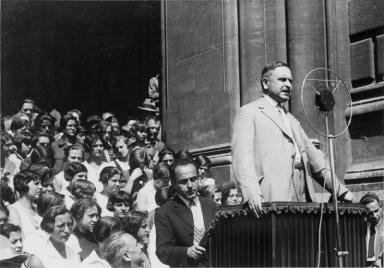 Otto Bauer gives a speech, ca 1925. As leader of the Social Democratic Party in the First Republic, Bauer's leadership and contributions to Austro-Marxist discourse would come to define the city in the Red Vienna period.One error of Marek Edelman, the Austofascist government of Engelbert Dollfuss fought against the socialist Austromarxist Republikanischer Schutzbund with their conservative and Austrofascist Heimwehr. The Austrofascists were both anti-Social Democratic (the Austromarxists) and against the Austrian Nazi's. And the authoritarian Austrofascist regime opressed both the Social democrats in Red Vienna and the National Socialists who got support from Nazi Germany. So in contrast with Marek Edelman I state the Austrian government was not Pro-German. The Austrofascists were supported by Italy, and it was a clerical corporatist, Roman Catholic, Austrian nationalist regime. Not a Nazi regime. Otto Bauer gives a speech, ca 1925. As leader of the Social Democratic Party in the First Republic, Bauer's leadership and contributions to Austro-Marxist discourse would come to define the city in the Red Vienna period.One error of Marek Edelman, the Austofascist government of Engelbert Dollfuss fought against the socialist Austromarxist Republikanischer Schutzbund with their conservative and Austrofascist Heimwehr. The Austrofascists were both anti-Social Democratic (the Austromarxists) and against the Austrian Nazi's. And the authoritarian Austrofascist regime opressed both the Social democrats in Red Vienna and the National Socialists who got support from Nazi Germany. So in contrast with Marek Edelman I state the Austrian government was not Pro-German. The Austrofascists were supported by Italy, and it was a clerical corporatist, Roman Catholic, Austrian nationalist regime. Not a Nazi regime. |
|
|
|
Austria
Jul 14, 2019 14:07:27 GMT -7
Post by pieter on Jul 14, 2019 14:07:27 GMT -7
The Austrian Green Party The Austrian Green Party (German: Die Grünen – Die Grüne Alternative, lit. 'The Greens – The Green Alternative') is a green political party in Austria. The Austrian Green Party (German: Die Grünen – Die Grüne Alternative, lit. 'The Greens – The Green Alternative') is a green political party in Austria.
The party was founded in 1986 under the name "Green Alternative" (Grüne Alternative), following the merger of the more conservative Green party Vereinte Grüne Österreichs (United Greens of Austria VGÖ, founded 1982) and the more progressive party Alternative Liste Österreichs (Alternative List Austria, ALÖ, founded 1982). Since 1993, the party has carried the official name Die Grünen – Die Grüne Alternative (Grüne), but refers to itself in English as "Austrian Greens". There are still differences between the former members of the old Alternative and VGÖ factions within the party, reflected in the differing approaches of the national and state parties.
Apart from ecological issues such as environmental protection, the Greens also campaign for the rights of minorities and advocate a socio-ecological (ökosozial) tax reform. Their basic values according to their charter in 2001 are: "direct democracy, nonviolence, ecology, solidarity, feminism and self-determination". The party is a member of the European Green Party and Global Greens.
The Greens currently have no seats in the National Council. Over the past decade, it had polled 11.0, 10.4, and 12.4 percent in federal elections. However, in 2017, the party was beset with internal difficulties including the defection of its entire youth wing. In the 2017 general election, the party suffered a disastrous defeat, losing all 24 of its seats by failing to clear the 4% hurdle to get representation in parliament. The Green Party spokesperson from Lower Austria, Helga Krismer-Huber described it as a 'catastrophe'. The party has 2 seats but no parliamentary group in the less powerful Federal Council.
|
|
|
|
Austria
Jul 14, 2019 14:11:36 GMT -7
Post by pieter on Jul 14, 2019 14:11:36 GMT -7
 NEOS (German: NEOS – Das Neue Österreich und Liberales Forum, lit. 'NEOS – The New Austria and Liberal Forum') is a liberal political party in Austria.HistoryThe party, founded in October 2012, contested the 2013 legislative election on a joint electoral list with the Young Liberals Austria and Liberal Forum. In the election held on 29 September 2013, NEOS received 4.9% of the vote and 9 seats in the National Council. NEOS (German: NEOS – Das Neue Österreich und Liberales Forum, lit. 'NEOS – The New Austria and Liberal Forum') is a liberal political party in Austria.HistoryThe party, founded in October 2012, contested the 2013 legislative election on a joint electoral list with the Young Liberals Austria and Liberal Forum. In the election held on 29 September 2013, NEOS received 4.9% of the vote and 9 seats in the National Council.
On 25 January 2014 NEOS absorbed the Liberal Forum, creating "NEOS – The New Austria and Liberal Forum". In March 2014, it also absorbed the independent Young Liberals (JuLis), forming the party's youth wing JUNOS – Young liberal NEOS.
NEOS became a full member of the Alliance of Liberals and Democrats for Europe (ALDE) on 2 May 2014.
In the 2014 European elections held on 25 May 2014, the party received 8.1% of the national vote, and returned a single Member of the European Parliament.Policies and political positionThe party supports more direct democracy using referenda, the ending of conscription, and the creation of United States of Europe. The party opposes increased property taxes and public financing of political parties.
|
|
|
|
Austria
Jul 14, 2019 14:29:05 GMT -7
Post by pieter on Jul 14, 2019 14:29:05 GMT -7
 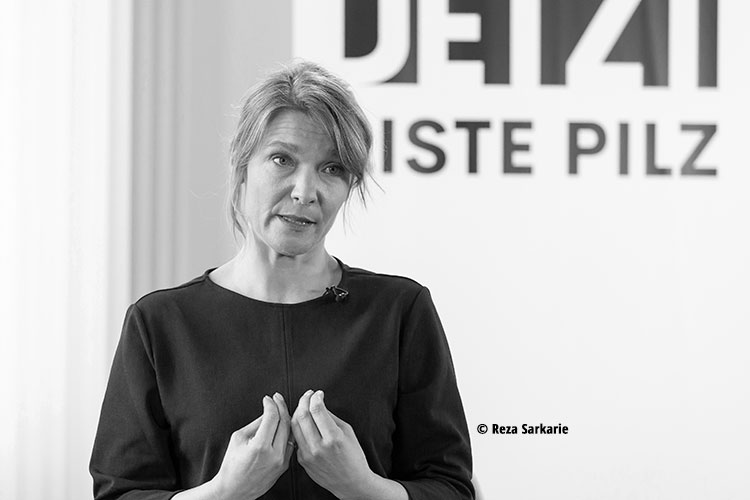 Maria Stern (born 5 September 1972) is an Austrian singer-songwriter, teacher, writer and politician. Since August 2018 she is the chairwoman of the Peter Pilz List.JETZT – Pilz List (German: JETZT – Liste Pilz, "jetzt" meaning "now"), formerly known as Peter Pilz List (Liste Peter Pilz), is a green and left-wing populist political party in Austria. The party was founded by the former Green parliamentarian Peter Pilz, and took part in the 2017 legislative election. Maria Stern (born 5 September 1972) is an Austrian singer-songwriter, teacher, writer and politician. Since August 2018 she is the chairwoman of the Peter Pilz List.JETZT – Pilz List (German: JETZT – Liste Pilz, "jetzt" meaning "now"), formerly known as Peter Pilz List (Liste Peter Pilz), is a green and left-wing populist political party in Austria. The party was founded by the former Green parliamentarian Peter Pilz, and took part in the 2017 legislative election.
The Pilz List won 8 seats with just over 4% of the vote, beating the Greens who failed to pass the 4% threshold and subsequently lost all of their seats. |
|
|
|
Austria
Jul 14, 2019 14:46:32 GMT -7
Post by pieter on Jul 14, 2019 14:46:32 GMT -7
|
|